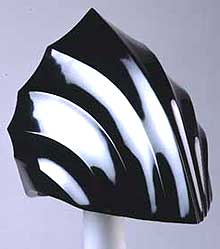| architecture |
| calligraphy |
| ceramics |
| clothing |
| comics |
| gardens |
| lacquerwork |
| literature |
| movies |
| music |
| painting |
| poetry |
| sculpture |
| tea ceremony |
| television |
| theatre |
| weaponry |
| thematic routes |
| timeline |
| the site |
context: lacquerwork > technical
Styles

|
a modern art object: Spirit of Darkness, 1988, by Natsuki Kurimoto |
Oddly, much lacquerware, where there is figuration, is rather more 'realistic' than most Japanese painting. I imagine the main reason for this is that the supreme valuation of the gesture, of the calligraphic brushstroke in one quick movement, could not apply to a technique so painstaking, so approaches that western eyes might see as expressionistic would rarely be used.
Also, there is much that we might see as abstract - but this is from a decorative impulse, more analogous to Islamic non-figurative art than to modern western abstraction.
A lot has changed for 20th Century lacquer artists, and many strands and tendencies are evident: harking back to the grand traditions, making abstract art objects, making traditional forms with modern decor, and so on. More colours are available (you won't see much white, yellow or purple on old lacquer), and more core materials. It's an artform now, not 'merely' a craft - whether this is a good thing or not is very much another question.
